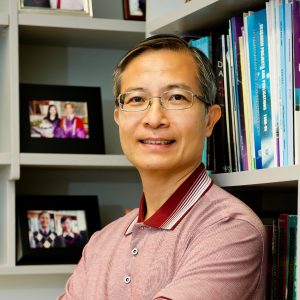
Emeritus Professor at the School of Biomedical Sciences
Office: (852) 3943 6879
Email: psleung@cuhk.edu.hk
Address: Room 609A, 6/F, Lo Kwee-Seong Integrated Biomedical Sciences Building, School of Biomedical Sciences, CUHK
SBS Website: https://www2.sbs.cuhk.edu.hk/en-gb/people/academic-staff/prof-leung-po-sing
Research Profile
Prof. LEUNG Po Sing (梁寶成) was Assistant Professor (1996-1998) and Associate Professor (1998-2003), and is currently Professor (2003-now) in the School of Biomedical Sciences, Faculty of Medicine, The Chinese University of Hong Kong (CUHK). He received his BSc in Biology (1986), The National Taiwan Normal University; PhD in Biochemistry (1993), The Queen’s University of Belfast; UK Soulby Postdoc Fellowship (1993-1994), Japan Science and Technology Agency Postdoc Fellowship (1994-1995); and CUHK Postdoc Fellowship (1995-1996).
Professor Leung has major research interest in the field of pancreatic islet cell health and diseases, with a particular focus on islet cell function and survival, as well as islet cell regeneration and development in diabetes. Since joining CUHK, he has been striving to investigate into novel factors that improve islet β-cell secretion while protecting β-cell apoptosis; these agents include FGF21, GPR120, vitamin D, GLP1 and the RAS over the past two decades. He has published over 200 original and review papers in international refereed journals as well as several books, book chapters, letters, commentaries, and editorials, etc. He has served editorial boards/associate editors of journals in the field, including Molecular Metabolism; Antioxidants & Redox Signaling; Diabetes, Obesity & Metabolism; American Journal of Physiology – Endo & Metab; Stem Cells & Development, etc.
Research Interests
- Pancreatic islet cell biology and diabetes
- Pancreatic progenitor cell and islet development
- Novel agents/drugs for treating diabetes and pancreatic cancer
Selected Publications
- Wu SY, Liang J, Yang B, Leung PS. “SIRT1 activation promotes β-cell regeneration by activating endocrine progenitor cells via AMPK signalling-mediated fatty acid oxidation.” Stem Cells (doi:10.1002/stem.3073; Epub ahead of print, 2019 Aug 10).
- Wang Y, Xie T, Zhang D, Leung PS. “GPR120 protects lipotoxicity-induced pancreatic beta-cell dysfunction through regulation of PDX1 expression and inhibition of islet inflammation in mice.” Clinical Science, 2019; 133:101-116.
- Chan KY, Wang Y, Ng KW, Leung PS. “Na+/H+ exchanger 3 blockade ameliorates type 2 diabetes mellitus via inhibition of SGLT1-mediated glucose absorption in the small intestine.” Diabetes, Obesity & Metabolism, 2018; 20:709-717.
- Zhang D, Xie T, Leung PS. “Irisin ameliorates glucolipotoxicity-associated beta-cell dysfunction and apoptosis via AMPK sigaling and anti-inflammatory actions.” Cellular Physiology & Biochemistry, 2018; 51:924-937.
- Li YT, Cheng TW, Zhang D, Leung PS. “Identification and functional implications of sodium/myo-inositol cotransporter-1 in pancreatic beta-cells and type 2 diabetes mellitus.” Diabetes, 2017; 66:1258-1271.
- Zhang D, So WY, Wang Y, Wu SY, Cheng Q, Leung PS. “Insulinotropic effects of GPR120 agonists are altered in obese diabetic and obese non-diabetic states.” Clinical Science, 2017; 131:247-260.
- Liang J, Wu SY, Zhang D, Wang L, Leung KK, Leung PS. “NADPH oxidase-dependent reactive oxygen species stimulate beta-cell regeneration through differentiation of endocrine progenitors in murine pancreas.” Antioxidants and Redox Signaling, 2016; 24:419-433.
- Cheng TW, Chen L, Li YT, Mayoux E, Leung PS. “The effects of empagliflozin, an SGLT2 inhibitor, on pancreatic β-cell mass and glucose homeostasis in type 1 diabetes.” PLoS One, 2016; 11: e0147391.
- So WY, Leung PS. “Fibroblast growth factor 21 as an emerging therapeutic target for type 2 diabetes mellitus.” Medical Research Reviews, 2016; 36:672-704.
- So WY, Cheng Q, Xu A, Lam SL, Leung PS. “Loss of fibroblast growth factor 21 action induces insulin resistance, pancreatic islet hyperplasia and dysfunction in mice.” Cell Death and Disease, 2015; 6:e1707.
